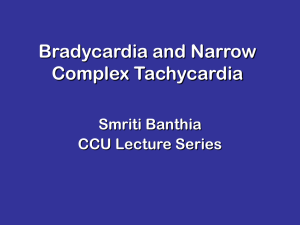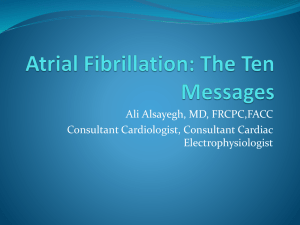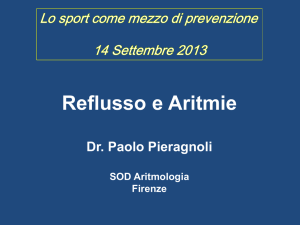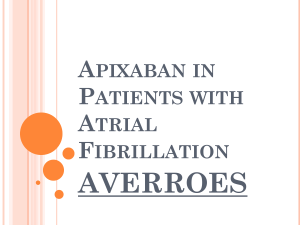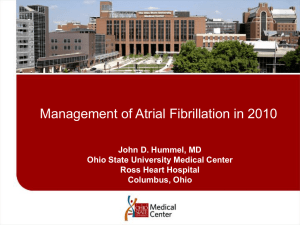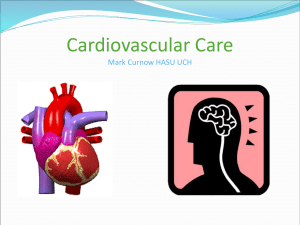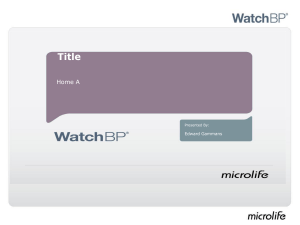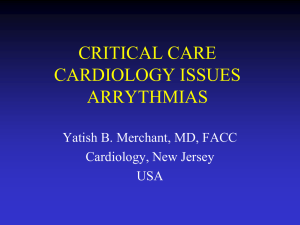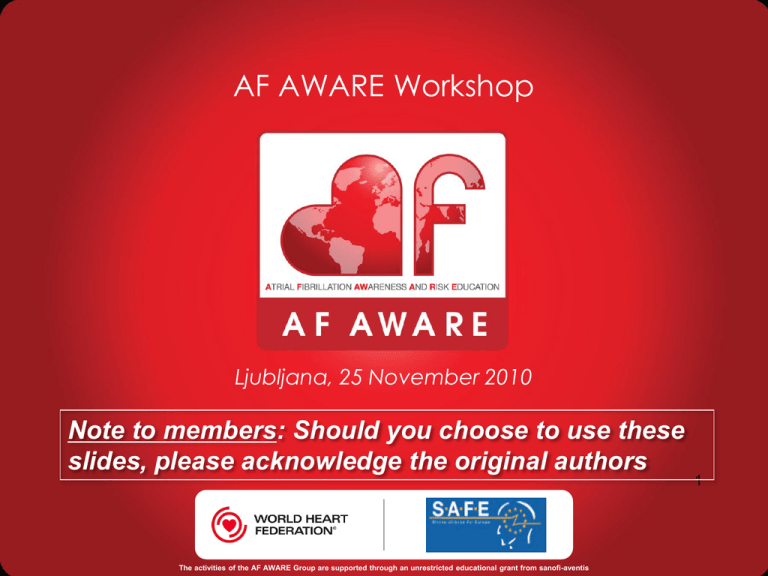
AF AWARE Workshop
Ljubljana, 25 November 2010
Note to members: Should you choose to use these
slides, please acknowledge the original authors
The activities of the AF AWARE Group are supported through an unrestricted educational grant from sanofi-aventis
1
Welcome & introductions
Dr Markus Wagner, President, SAFE
Our panel
• Professor Günter Breithardt - World Heart Federation
• Leela Barham – Independent Health Economist,
Report author
• James Beeby – Corporate Partnerships, The Stroke
Alliance for Europe
• Graham Minton - Director, Corporate Relations, World
Heart Federation
3
Today’s objectives
• Update on AF AWARE campaign activities to date
• Share findings from the AF in Europe: How AWARE
are you? research
• Brainstorm ideas for taking the AF AWARE campaign
forward
• Discuss effective research process
4
Agenda: Morning
Time
Topic
Speaker(s)
10.00
Welcome & Introductions
Dr Markus Wagner
10.10
Atrial Fibrillation (AF) – the growing burden
in Europe
Prof. Günter Breithardt
10.30
Taking action – the AF AWARE campaign
so far
Graham Minton & James Beeby
10.50
Coffee Break
11.10
Atrial Fibrillation in Europe: How AWARE
are you?
Leela Barham & J. Beeby
Research findings
11.50
Audience Q&A
12.10
Lunch
Facilitated by J. Beeby
5
Agenda: Afternoon
Time
Topic
Speaker(s)
13.10
AF management in Europe: Filling the gaps
Weber Shandwick
Introduction to Workshops
13.20
Break out into workshop groups
Workshop sessions - All
14.30
Coffee Break
14.45
Workshop feedback session
Representatives from
workshop groups
15.15
Summary of next steps
Dr Markus Wagner
15.30
Meeting Close
Dr Markus Wagner
6
A few housekeeping items
• Interactive day – share your opinion
• Complete questionnaire and return to
registration desk during morning coffee break
• Complete evaluation form and return to
registration desk at the end of the day
7
Atrial Fibrillation (AF) – the
growing burden in Europe
Professor Günter Breithardt
World Heart Federation
8
AF AWARE – Member Workshop
SAFE Conference
25 November 2010, Ljubljana, Slovenia
Atrial Fibrillation (AF) – the growing
burden in Europe
Westfälische
WilhelmsUniversität
Münster
Prof. Dr. Dr. h.c. Günter Breithardt
Universitätsklinikum Münster
Dept. of Cardiology and Angiology
Atrial Fibrillation Network (AFNET)
Münster / Germany
What is atrial fibrillation?
•
•
In patients with atrial fibrillation, heart beats are completely
irregular and often the heart rate is too fast or too slow
Atrial fibrillation is the most common clinically relevant
heart rhythm abnormality affecting people worldwide:1-4
•
•
•
Over nine million people in the EU and the US alone suffer from
atrial fibrillation
One in four people aged 40 years or older develop atrial fibrillation
The number of people with atrial fibrillation is expected to double
by 2050
1. Stewart S, Murphy N, Walker A, et al. Heart 2004; 90:286-92; 2. Fuster V, Rydén LE, Cannom DS, et al. Circulation 2006;
114:e257-e354; 3. Miyasaka Y, et al. Circulation 2006; 114:119-125; 4. Lloyd-Jones DM, Wang TJ, Leip EP, Larson MG, Levy D,
Vasan RS, et al. Circulation 2004; 110:1042-6.
Prevalence of diagnosed Afib in adults
National Implications for Rhythm Management and Stroke Prevention: the
AnTicoagulation and Risk Factors In Atrial Fibrillation (ATRIA) Study
WWU Münster
Alan S. Go, et al., JAMA.
2001;285:2370-2375
Prevalence of Diagnosed Atrial Fibrillation Stratified by Age and Sex
The AF epidemic
15,2
Patients with atrial fibrillation (millions)
16
15,9
14,3
13,1
14
Mayo Clinic data (assuming a
continued increase in the AF
incidence)
11,7
12
10,2
10
11,7
11,1 Mayo Clinic data (assuming no
8,9
10,3
7,7
8
8,4
5,9
7,5
5,1
6
5,1
4
6,8
5,6
6,1
4,34
2
2,08
2,26
further increase in the AF
incidence)
9,4
6,7
12,1
2,44
2,66
2,94
3,33
4,78
5,16
5,42
5,61
ATRIA study data
3,8
0
1990 1995 2000 2005 2010 2015 2020
2025 2030 2035 2040 2045 2050
Year
slide by J Camm
Lifetime risks for developing AF are 1 in 4
Women
Men
30
26.0
Lifetime risk for AF (%)
25
23.0
25.9
23.2
25.8
23.4
24.3
23.0
22.7
21.6
20
15
10
5
0
40
50
60
Age (years)
Lloyd-Jones DM, et al. Circulation 2004;110:1042-6
70
80
Why does atrial fibrillation occur?
Electrical signals misfire
Contractions of the atria (upper chambers of the heart) are
irregular and the heart beats are often too fast or too slow
Blood pools in the atria because there is stasis of blood;
not all of the blood is pumped to the ventricles (lower
chambers of the heart)
The heart cannot pump effectively
1. Atrial Fibrillation Fact Sheet, National Heart Blood and Lung Institute Diseases and Conditions Index, October 2009. Last viewed
June 2010 at http://www.nhlbi.nih.gov/health/dci/Diseases/af/af_what.html; 2. Atrial Fibrillation Factsheet, Patient UK, March 2008.
Last viewed June 2010 at http://www.patient.co.uk/health/Atrial-Fibrillation.htm
What causes atrial fibrillation?
• Whilst some cases of atrial fibrillation have no known
cause, conditions and lifestyle factors known to lead to
atrial fibrillation include:1,2
Age
High blood pressure
Diabetes mellitus
Having an overactive thyroid gland
Heart failure
Drinking too much alcohol or binge drinking
• Atrial fibrillation is more common in people who have
heart disease or heart-related conditions like heart
failure2,3
1. Lloyd-Jones DM, Wang TJ, Leip EP, Larson MG, Levy D, Vasan RS, et al. Circulation 2004; 110:1042-6; 2.
http://www.nhlbi.nih.gov/health/dci/Diseases/af/af_what.html; 3. http://www.patient.co.uk/health/Atrial-Fibrillation.htm.
What are the symptoms of atrial fibrillation?
• Symptoms may be experienced on a regular basis,
intermittently or not at all:1,2
Fatigue, palpitations, dizziness, chest pains and breathlessness
• Many people with atrial fibrillation lack any symptoms:1-3
More than half of episodes of atrial fibrillation are not felt by the patient
• Atrial fibrillation if present can be diagnosed using an
electrocardiogram4
Regular rhythm
P wave
Irregular rhythm
No P wave
1. http://www.nhlbi.nih.gov/health/dci/Diseases/af/af_what.html; 2. http://www.patient.co.uk/health/Atrial-Fibrillation.htm; 3.
PAFAC and SOPAT trials 4.Ashley EA & Niebauer J. Cardiology explained. Remedica: London 2004.
Asymptomatic atrial fibrillation
•
WWU Münster
Asymptomatic atrial fibrillation is a substantial problem
for invidual health and for the health care system:
it may cause stroke
it is frequent despite antiarrhythmic drug therapy or
catheter or surgical ablation
(it may cause cognitive dysfunction and dementia)
Natural time course of AF
10% recurrent AF in first year, 5% per annum thereafter
mortality 2 – 3 fold increased in AF (1.5 – 4 % per year)
Recurrences of paroxysmal AF not randomly distributed
marked reduction in quality of life
1st AFNET/EHRA consensus document
Kirchhof P et al. Eur Heart J 28, 2803-2817 / Europace 9, 1006-23 (2007)
How does atrial fibrillation lead to stroke?
Blood pools in the atria
Blood clot forms
Whole or part of the blood clot breaks off
Blood clot travels to the brain
and closes a cerebral artery
causing a stroke
1. Atlas of Heart Disease and Stroke, World Health Organization, September 2004. Last viewed June 2010 at
http://www.who.int/cardiovascular_diseases/en/cvd_atlas_15_burden_stroke.pdf
What is a stroke?
• A stroke is the brain equivalent of a heart attack (i.e. a
myocardial infarction). Blood must flow to and through
the brain for it to work properly
• If this flow is blocked by a blood clot, the brain loses its
energy and oxygen supply, causing brain damage that
can lead to disability or death1
Area of stroke
Artery occlusion
by blood clot
1. World Health Organization, Atlas of Heart Disease and Stroke,
http://www.who.int/cardiovascular_diseases/en/cvd_atlas_15_burden_stroke.pdf.
How do you measure the risk of stroke?
• CHADS2-Score: a simple index that is widely used to assess
the risk of stroke of a patient with atrial fibrillation. It can be
used to guide antithrombotic therapy
Congestive heart failure history - 1 point
Hypertension history - 1 point
Age > 75 years -1 point
Diabetes mellitus history -1 point
Stroke or TIA history - 2 points
• The higher your CHADS2-Score, the higher your risk of having
a stroke
• This score has been expanded in 2010 by additional factors:
female gender, age between 65 and 74 years, presence of
vascular disease: CHA2DS2VASc
1. Fuster V, Rydén LE, Cannom DS, et al. Circulation 2006; 114:700-52.
What is the link between atrial fibrillation and
stroke?
• People with atrial fibrillation are five times more likely
to have a stroke:1
•
20-30% of strokes are related to atrial fibrillation2
Up to three million people worldwide have an
atrial fibrillation-related stroke every year
– that is one person every 12 seconds!3-5
1. Fuster V, Rydén LE, Cannom DS, et al. Circulation 2006; 114:700-52; 2. The Copenhagen Stroke Study. Jørgensen
HS, Nakayama H, Reith J, et al. Stroke. 1996;27:1765-1769; 3. Wolf PA, Abbott RD, Kannel WB. Stroke 1991; 22(8):983-8;
4. Lin HJ, Wolf PA, Kelly-Hayes M, et al. Stroke 1996; 27:1760-4; 5. Atlas of Heart Disease and Stroke, World Health Organization,
September 2004. Viewed July 2009 at ttp://www.who.int/cardiovascular_diseases/en/cvd_atlas_15_burden_stroke.pdf.
How is atrial fibrillation treated?
• Antithrombotic therapy:
Antiplatelet and anticoagulant medications (blood thinning therapies)
• Rate control:
Achieving ‘normal’ heart rates
• Rhythm control may be attempted in selected patients:
Cardioversion: using electricity
Cardioversion: using antiarrhythmic drugs
Catheter or surgical ablation(s)
• Major issues at present:
Early management by rhythm control therapy?
Antiarrhythmic drugs versus catheter ablation?
Better prevention of stroke by novel drugs: health care costs, benefits?
Why is stroke prevention in atrial
fibrillation sub-optimally managed?
•
Only half of diagnosed patients with atrial fibrillation at
risk of stroke receive anticoagulation therapy:1-4*
Vitamin K antagonists (VKAs) are highly effective when a
patient’s blood clotting value is maintained within the
narrow therapeutic INR range of 2.0-3.0
Fewer than half of patients on VKAs are controlled within
this narrow therapeutic range
Patients with a very high risk of stroke (e.g. elderly
patients with co-morbidities) are withheld oral
anticoagulation due to fear of the risk of bleeding
* e.g. warfarin, a vitamine K antagonist
1. Dulli DA et al. Neuroepidemiology 2003;22:118–23; 2. Hylek EM, DAntonio J, Evans-Molina C, et al. Stroke 2006; 37:1075-80;
3. Hart GR, et al. Ann Intern Med. 2007; 146:857-867; 4. Samsa GP, Matchar DB, Goldstein LB, et al. Arch Intern Med
2000;160:967-7.
AFNET
Use of anticoagulation and antiplatelet therapy in the different
age groups of high or very high stroke risk pts
Stroke rates in relation to age among pts in
untreated control groups of randomized trials.
Arch Intern Med 1994;154:1449–57
Ohne Kardioversions- und Ablationspatienten
Näbauer, Meinertz, et al.
Initiation and persistence of warfarin or aspirin in pts
with chronic afib in general practice: do the
appropriate pts receive stroke prophylaxis? (U.K.)
WWU Münster
Proportion of patients initiating warfarin or aspirin stratified by age
and CHADS2 score.
AM Gallagher, et al., J Thromb Haemost 2008; 6: 1500-6
Country distribution of mean time in
therapeutic range in the RE-LY trial
WWU Münster
Lars Wallentin et al., Lancet 2010; 376: 975–83
Why is awareness of atrial fibrillation low?
• Many people are unaware of the increased risk and
potential life changing consequences of having an atrial
fibrillation-related stroke, many of which can be
prevented:1
In the AF AWARE international survey, 46% of physicians agreed
that their patients would not be able to explain atrial fibrillation
A quarter of physicians thought atrial fibrillation was too complex
to explain during a clinic visit or that they did not have enough
time
There is a need for increased
awareness and understanding
1. http://www.world-heart-federation.org/fileadmin/user_upload/images/AF-Aware/AF%20AWARE%20booklet%20v11.pdf.
Thank you very much for
your attention
Taking action – the AF
AWARE campaign so far
Graham Minton & James Beeby
30
The World Heart Federation
•
Mission statement: “The World Heart Federation unites its members
and leads the global fight against heart disease and stroke, with a focus
on low and middle income countries.”
•
Community of nearly 200 member organizations – societies of
cardiology and heart health charities
•
The World Heart Federation advocates for fair and equal cardiovascular
health policies, generates and exchanges ideas, shares best practice
and advances scientific knowledge to tackle the world’s number one
killer
31
The Stroke Alliance for Europe
•
Mission statement: “We work towards all patients in Europe with stroke
having rights of access to a continuum of care. From prevention and risk
identification, through emergency response to organised stroke units in
acute phase, to appropriate rehabilitation and secondary prevention
measures by 2015.”
•
22 members in 17 countries across Europe
•
Current role – sharing best practice and developing patient groups
across Europe
•
Future aspirations – centralised lobbying, and greater building of
alliances at an EU level
32
What is AF AWARE?
• AF AWARE (Atrial Fibrillation AWareness
And Risk Education) is a campaign dedicated
to gaining greater recognition of atrial
fibrillation (AF) as a major international public
health concern through exposing current
misperceptions of the condition and focusing
attention on the realities of the disease
33
We aim to move perception to reality
AF PERCEPTION
AF REALITY
AF is a severe CV
disease within the CV
continuum
An isolated low risk
disease
requiring symptom
management and stroke
prevention
AF has direct morbidity
and mortality impact
34
Campaign goals
• Raise awareness of AF and its links to stroke and other
cardiovascular complications
• Improve prevention, diagnosis and optimal management of
AF
• Highlight the impact that AF can have on patient quality of
life
• Illustrate the socio-economic burden associated with AF
• Educate healthcare professionals, patients, policy makers
and the adult population on the management of AF
35
Campaign launch
• Close the Gap global
survey in 11 countries
demonstrated lack of
awareness and
education of AF
amongst patients and
physicians
• Call to action launched
at ESC 2009
36
Campaign toolkit for local roll-out
CONTENTS:
1.
2.
3.
4.
Media outreach & press events
guidance
Media materials
•
Template press release
•
Template slides
•
AF backgrounder
•
Video of AF AWARE
spokespeople
AF AWARE Booklet
Template survey fact sheet
and local results grids
All available on the World Heart Federation website
Europace Article Published April 30th 2010
• Article published on the
results of the ‘Close the
Gap’ survey
• Given media support
from World Heart
Federation
• Good media pick up –
with 47 million audience
impressions and
featured on 260 sites
38
World Congress of Cardiology - Beijing
• ‘Members Pack’ created
including all existing
materials, with key
elements in Chinese
• Promoted at the World
Heart Federation
members meeting
• Prominent panel and
display on the World
Heart Federation booth
39
World Congress of Cardiology - Beijing
• Press release and media
outreach in Asia-Pacific around
the results of the ‘Close the
Gap’ survey
• One to one interviews
conducted by World Heart
Federation Senior Science
Officer and Dr. Zhang
• The result: 59 articles including
front page of ‘Health News’ and
articles in ‘Beijing daily’,
‘Reference News’ and
‘Shanghai Evening Post’ with
readership of over 9.6 million
Health Times 健康时报
AF in Europe: How AWARE are you?
• Report commissioned by SAFE and
World Heart Federation to:
–
Assess and evaluate AF management
situation in Europe
–
Assess accessibility and content of patient
information in Europe
–
Evaluate incidence and prevalence of AF in
Europe
–
Estimate economic burden of AF in Europe
• Report launched to pan-European
media earlier this week at the time of
the EuropeAF conference
41
Coffee break
42
Atrial Fibrillation in Europe:
How AWARE are you?
Research Findings
Leela Barham & James Beeby
Leela Barham
Independent health economist
Contact: leels@btinternet.com
Outline
•
•
•
•
Study objectives
Study methodology
Findings
Areas for potential future research
44
Study objective
• Against a background of concern of a lack of
awareness of AF and a lack of comparable
information and on data across Europe…
• ...the objective was to assess what is currently
known about each of these across Europe and
Russia
45
Study methodology
• Recognised that there are a number of approaches which could
be used to explore these issues, but reflecting on limited time,
resources and applying pragmatism, the approach was to:
– Conduct a rapid evidence review: bringing together English
language literature published between 2005 and 2010
– Survey member organisations of SAFE and the World Heart
Federation by email. Their valuable input is greatly
appreciated
• See this as a starting point with scope to build up a clearer picture
over time
46
Incidence and prevalence
47
Incidence and prevalence
• Basic numbers missing for many countries…
• …complexities from this condition; ‘silent’
cases
• Expectation of rise in cases over time
• Disease registries can provide answers but
are few and far between across Europe
48
Healthcare system response to AF
• AF can be diagnosed and managed by: opportunistic screening,
ECGs, cardioversion to return the heart to normal rhythm and
anticoagulation to reduce the risk of blood clots which can cause
stroke
• Management differs according to the type of AF and according to
the specific patients’ characteristics such as the presence of
comorbidities
• Range of professionals involved: nurses, GPs, specialists
• Variety of treatment options but newer treatments (e.g.
dronedarone) may not be available or unclear if available
49
Health care professionals involved in
diagnosis and management
50
Availability of treatments
51
Sub optimal treatment
52
Healthcare system response to AF
•
•
•
•
•
Range of guidelines exist:
– National, e.g. National Institute for Health and Clinical Excellence
guidelines for the national health service (NHS) in England and
Wales
– European, e.g. European Society for Cardiology guidelines
Adherence to guidelines is variable; both over use and under use of oral
anticoagulants and a lack of tailoring of management to specific patients’
characteristics
No single country appears better or worse in their adherence to
guidelines and there is likely to be scope for improvement across many
countries
Moving practice closer to guidelines could improve patient outcomes by
reducing the risk of mortality and avoiding stroke….
…would also bring benefits to the health care system by reducing the
demand for relatively expensive hospitalisations. This presents a
missed opportunity to benefit both patients and the healthcare system53
Patient information
• Variety of information available to patients:
– leaflets
– websites
– telephone helpline (UK)
• Survey respondents are not convinced that what is available is
sufficient to meet the needs of patients, and many had concerns
about whether patients had the information that they needed to
be a partner in treatment decisions with their clinician (Belgium,
Norway, Lithuania and Germany)
• There is also a gap in understanding patient preferences which
links back to adherence to guidelines for management; perhaps
providing accessible information to patients will help to bridge the
gaps
54
Economic burden
55
Economic burden – health care
activity
56
Types of health care costs
s
57
Economic burden – health care costs
58
Economic burden
• The ‘right’ level of expenditure in the health care system is difficult
to determine
• Evidence suggests that achieving International Normalised Ratio
(INR) for patients on warfarin in Sweden could lead to later cost
offsets in the health care system by avoiding strokes
• A similar value for money argument has also been put forward in
the UK, where opportunistic screening of primary care patients
can cost in the order of £200 per newly treated patient, but leads
to fewer strokes, and hence reduced demand for relatively more
expensive stroke care
59
Economic burden – indirect cost
60
We know…..
•
•
•
•
•
•
•
•
AF is increasingly common, affecting up to 2 per cent of the general population
The number of people with AF is set to grow over time, perhaps even doubling
in the next 50 years
AF prevalence is likely to be underestimated because it can be silent
AF is a complex disease to diagnose and manage with a need to tailor the
management according to patients’ characteristics
There are missed opportunities to more successfully manage AF by adhering to
guidelines which can contribute to better outcomes for patients, and reduce
demand on health care systems
Patient information is available but isn’t sufficient, a concern shared by patient
organisations and clinicians
AF results in a substantial cost of illness because it uses significant resources
across primary and secondary care. In particular hospitalisations are expensive,
and this is key driver of the costs of AF. Appropriate management, particularly the
use of medicines can lead to reduced demand for expensive hospital care
AF results in substantial loss of work
61
…but we need to know more
•
There is a lack of country estimates of incidence and prevalence of
AF
– This implies that there may be scope for greater understanding of the extent
of AF within countries. Perhaps the lack of country level estimates
contributes to the concern expressed by SAFE and the World Heart
Federation that there is a lack of awareness of AF. It is also likely to hinder
effective planning within the health care system to provide treatment and
management for those with AF
•
Registries are not routinely available but more are being planned
– This should help meet some informational gaps
•
There are guidelines for management but there is variation in
adherence – the reasons are not fully known
– This implies a need for more in-depth research to explore the key barriers
and enablers to move closer to meeting these guidelines in practice.
Promising solutions include more education for clinicians and providing
information to patients
62
…and there are promising options to
explore for the future
•
•
•
•
•
•
•
Updating the available costs of AF
– This would be useful to inform planning and resourcing in the future
Draw upon the estimates of the cost of stroke and apportion costs to AF
– This would be useful to highlight the burden where it is currently opaque
Explore the potential to extrapolate based upon available data to countries where
no data exists
Build on the momentum seen for disease registries and use them to collect as
much information as is both useful and proportionate
Explore reasons for lack of adherence to guidelines with clinicians and patients
Work with patient organisations to identify the best approaches to fill the
information gaps for patients
Work with providers of clinical training to assess the appropriate content and
frequency of training on AF
63
Download the report by clicking on
the image below
64
Audience Q&A
Facilitated by James Beeby
65
Is AF the key or main area of focus
for your organization?
70%
60%
Percentage
50%
40%
30%
20%
10%
0%
Yes
No
No answer
66
Confidence regarding in-house
expertise on AF
100%
90%
80%
70%
No answer
60%
Don't know
50%
4. Not confident at all
3. Not very confident
40%
2. Confident
30%
1. Very confident
20%
10%
0%
Prevalence and
incidence
Management/
treatment of AF
Availability of patient Economic burden of
information
AF
67
Member access to external expertise
on AF
100%
90%
80%
70%
60%
Don't know
4. Not easy at all
50%
3. Not so easy
40%
2. Easy
1. Very easy
30%
20%
10%
0%
Prevalence and
incidence
Management/
treatment of AF
Availability of patient Economic burden of
information
AF
68
Areas of concern
100%
90%
80%
70%
60%
No answer
50%
No concern
A little concern
40%
Some concern
30%
Serious concern
Greatest concern
20%
10%
0%
The lack of
Lack of knowledge Lack of clinician Insufficient patient
Insufficient
awareness and
of clinical
adherence to materials available country data
understanding of
guidelines
treatment
available on AF
AF amongst HCPs amongst clinicians
guidelines
prevalence and
and patients
treatment
69
Audience Q&A
• Prioritizing AF
– Does your organization make the link between AF
and stroke?
– Is AF a priority for your organization?
• Effective research processes
– Challenges with the questionnaire
– In-house vs. external support
– Streamlining future research efforts
70
Lunch
71
AF management in Europe:
Filling the gaps
Workshop Sessions
72
Workshop A – Improving patient/caregiver
information
Willy Devriesere
Antje Marquardt
Guisepee Bonatto
Gianfranco Falco
Debbie Wilson
Tamar Janelidze
Adam Siger
Anna Novitskaya
Lilia Zviagina
Anna Kontsevaya
Workshop B – Helping move practice closer
to guidelines
• Dr. Markus Wagner
• Lineke Dijkstra
• Arne Hagen
• Chatarina Lindgren
• Raphael Bene
• Branko Malojcic
• Thorir Steingrimsson
• Wlodzimierz Dluzynski
• Anton Grad
• Dr. Günther Breithardt
Workshop C – Raising the profile of AF with
policymakers
• Esteban Pont Barceló
• Sandra Levy
• Jan op ‘t Land
• Jon Barrick
• Jasiminka Delilović Vranić
• Mikheil Shavquildze
• Maja Bozinovska
• Maria Panchenko
• Anat Moshe
Workshop D – Raising the profile of AF in the
media
• Manuela Messmer-Wullen
• Pnina Rosenzweig
• Ruza Acimovic Janezic
• Jelka Jansa
• Nicola Skingle
• Volha Zmachynskaya
• Sigurdur Hjalti Sigurdarson
• Carmen Ferrer
• Eva Jané Aleix
• Irina Hubetova
73
• Miran Kenda
•
•
•
•
•
•
•
•
•
•
Coffee break
74
Workshop feedback session
Facilitated by Dr Markus Wagner
75
Summary of next steps
Dr Markus Wagner
76
Thank you
77


